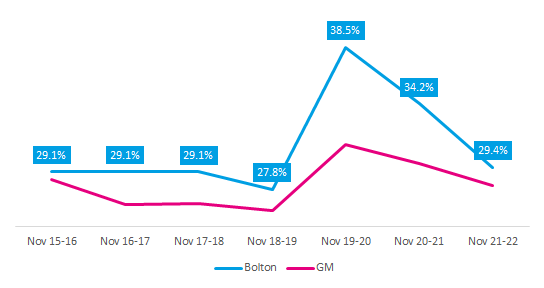Bolton Adult Activity Levels 2021-22
The latest Active Lives results published by Sport England show that Bolton has recovered to baseline levels for both active (57.1%) and inactive (29.4%) levels and showing further improvements to pre-pandemic levels for activity.
Bolton Overview
Bolton has recovered to baseline levels for both active (57.1%) and inactive (29.4%) levels and is showing further improvements to pre-pandemic levels for activity.
Similar to GM, 16-34 years inactivity levels were increasing before the pandemic, but have not seen any recovery in the last 12 months. Further unlike GM males, those with a long-term health condition or disability and from NS SEC 3-5 groups were also increasing.
Inactivity
The inactive population has seen a decrease in the last 12 months (-4.8%) but is still slightly above baseline (+0.3%) and higher than pre-pandemic levels (+1.7%).

Differences across demographics
Similar to Greater Manchester (GM), 16-34 years inactivity was increasing before the pandemic, however unlike GM males, LTHC and NS SEC 3-5 were also increasing before.
Most demographics have seen a decrease in the last 12 months, except 16-34 years. Along with males, NS SEC 3-5 and NS SEC 6-8 groups and South Asian ethnicities these have not recovered to baseline or pre-pandemic levels, and are all above GM levels, suggesting the impact of the pandemic has been greater for these groups.
Those with a LTHC have recovered to pre-pandemic but not baseline levels.
Whereas females, 35-54 and 75+ years, White British and NS SEC 1-2 have recovered to baseline and pre-pandemic, suggesting the impact of the pandemic has been less for these groups. Along with 55-74 years and those with no LTHC which have recovered to baseline but not quite pre-pandemic.

If you have questions about this data please email: [email protected]
Published April 2023
